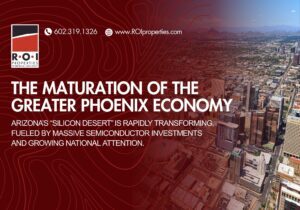
Beth Jo Zeitzer, Esq. is the owner and designated broker of R.O.I. Properties, a full-service real estate brokerage firm focused on working with business owners, investors and property owners, regarding the marketing and sale of commercial and residential properties, including retail, office, industrial, multifamily, hospitality and land assets. She can be reached at (602)319-1326 or [email protected].
Forget everything you’ve ever heard about location, location, location being the key to real estate. When it comes to income-producing commercial real estate, there are numerous factors to consider beyond the physical structure and cross-streets of a given building.
Commercial real estate experts generally use three different methodologies to evaluate income-producing properties: (1) market comparable sales, the evaluation of comparative closed sales and listings against the property being valued; (2) reproduction cost, the evaluation of the cost of reproducing a given building; and (3) income capitalization, the valuation approach that focuses on the projected future income stream.
Doing the Math
While the underlying math is fairly rudimentary, it’s essential to perform it accurately. Even the slightest variances can cause significant swings in property values and long-term potential.
The analysis starts with determining net operating income (NOI). On the income side, that includes scheduled gross income, such as rent, parking, vending and other sources, then deducting for vacancy or collections losses. This gives the investor a calculation of effective gross income (EGI). From there, operating expenses, such as taxes, utilities, maintenance and property management costs are deducted.
The applicable capitalization rate or cap rate can be difficult to ascertain, depending upon the property type, the submarket statistics, the credit of the tenant base (national, regional, local and actual financial condition of the tenant), the longevity of the lease, and the rental rates (at market, above market, below market, etc.). The cap rate relationship is inverse to the real estate value; the higher the cap rate, the lower the price of the property. For example, on a property with an NOI of $150,000, a cap rate of 10 percent translates to a value of $1.5 million. Drop the cap rate to 8 percent, however, and the property jumps to a value of $1.875 million.
Who sets the cap rate, and what are rates now? There’s no simple answer – and the prudent investor will enlist a commercial real estate expert for an accurate valuation and the applicable cap rate. For example, most class A institutional apartment deals are selling for prices in the 5-6 percent cap rate range. Office buildings might be at 8-9 percent in Phoenix (a secondary market), but tertiary markets such as Tucson, or suburban or ex-urban markets like Apache Junction, Maricopa, or Green Valley, may warrant lower values, and a 9-10 percent cap rate for similar properties.
Ultimately, cap rates are driven by the marketplace: What are buyers willing to pay and how much return do they need to make a deal happen? We are now in a competitive investment environment with very few distressed properties available. Cap rates are lower than they were a few years ago, which translates to less risk from the investor’s perspective. Less product and higher investor demand results in higher property prices and lower cap rates.
Cap Rate Caveats
Those of us who work daily in commercial real estate can attest that there are several common pitfalls when valuing income-producing properties. The first is that advertised cap rates may be misleading. You might think, “Wow, a cap rate of 8.5 percent,” only to realize that the seller is using pro forma or projected income and expenses rather than actual numbers. A property owner positioning a property for sale should have a formal profit and loss statement and a balance sheet on each asset from which to determine NOI. The reality is that many owners are not sophisticated, and may not have a full set of financials. Investors who fail to investigate financials and verify income and expenses are doing themselves a disservice.
While cap rates should be in line with market rates for the specific asset class, the submarket, comparable properties, and tenant base/credit, they should also align with market comparable sales. Planning for multiple exit strategies, even with a tenant base that looks stable, is necessary and prudent. For example, a net-lease tenant with good credit might merit a low cap rate, because there’s little risk to the prospective buyer. Since the tenant is assuming all of the expenses related to the property, however, an investor needs to ensure that market comparable sales and rentals provide an opportunity to secure another tenant if the current tenant leaves.
Finally, not only are there different cap rates for each asset class, there are other metrics, such as unit cost (apartments), per door (hotels), per square foot (office, retail and industrial), and so on. A full underwriting of an asset also involves financing considerations and an in-depth, due-diligence analysis to ensure that the investment property is in line with the marketplace.
As vital as it is, cap rate is only part of the equation in evaluating income-producing properties for investors. A full valuation involves comprehensive data regarding the financial, physical and operational aspects of a property and submarket, and will provide an investor with the tools that he or she needs to be able to make sound investment decisions.










